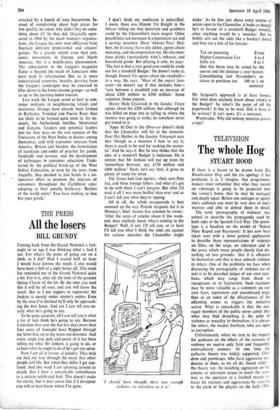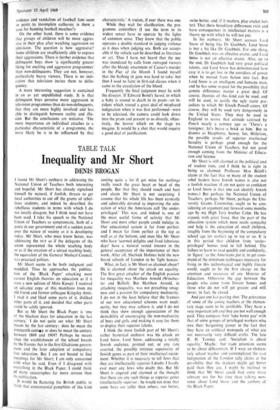The whole Hog
TELEVISION STUART HOOD
If there is a lesson to be drawn from Big Breadwinner Hog and the ITA apology it has produced, it is, I imagine, that programme- makers must remember that what they record on videotape is going to be projected into the viewer's home, that he may be outraged and deeply upset. Before one outrages or upsets one's audience one must be very sure of one's motives and able to defend them in detail.
The term 'pornography of violence' was coined to describe the propaganda used by both sides in the Spanish Civil War. The proto- type is a headline on the model of 'Naked Nuns Raped and Bayoneted.' It has now been taken over with a more general application to describe those representations of violence on films, on the stage, on television and in the press, which many people clearly find dis- turbing on two grounds : that it is offensive to themselves and that it may unleash violence in others. One of the problems we face when discussing the pornography. of violence (or of sex) is to be detached judges of our own reac- tions, which may range from shock to repugnance or to fascination. Such reactions may be more valuable as a comment on our own fears, repressions and unconfessed urges than as an index of the effectiveness of the offending scenes as triggers for imitative action. What is remarkable is that the out- raged members of the public never admit that what they find disturbing is the echo of violence or sexuality in themselves; it is always the others, the weaker brethren, who are open to corruption.
Unfortunately, when we turn to the experts for guidance on the effects of the mimesis of violence we receive only faint and frequently contradictory answers. At one time the cathartic theory was widely supported. Chil- dren and grown-ups, who have aggressive ten- dencies in them, as we all do, found relief— the theory ran—by watching aggression on the cinema or television screen in much the same way as the spectator at a football match re- leases his tensions and aggressions by reacting to the clash of the players on the field. (The
violence and vandalism of football fans seem to point to incomplete catharsis; is there a case for banning football matches?) On the other hand, there is some evidence that groups of children will be more aggres- sive in their play after watching aggression on television. The question is bow aggressive? Some children are insufficiently able to express their aggressions. There is further evidence that delinquent boys show 'a significantly greater liking for exciting and aggressive programmes' than non-delinquents. They are not, however, particularly heavy viewers. There is no indi- cation that television incites them to delin- quency.
A more interesting suggestion is contained in an as yet unpublished study. It is that delinquent boys perceive more aggression in television programmes than do non-delinquents, that they are more highly involved and less able to distinguish between reality and illu- sion. But the conclusions are tentative. 'The more importance an individual attaches to a particular characteristic of a programme, the more likely he is to be influenced by that characteristic.' A truism, if ever there was one.
While they wait for clarification, the pro- gramme controllers (I use the term in its widest sense) have to operate by the lights of common sense. They know that the public operates a double standard in judging violence as it does when judging sex. Both are accept- able if the vehicle can be described as literature or art. Thus I have not heard that the BBC was inundated by calls from outraged viewers after the bloody enactment of Caesar's murder in the Play of the Month. I found myself that the bathing in gore was hard to take; but then I used to faint in first-aid classes when it came to the circulation of the blood.
Frequently the final judgment must lie with the director. If Edward Bond's Saved, in which a baby is stoned to death in its pram—an in- cident which roused a great deal of misplaced indignation when it was first performed—were to be televised, the camera could look down into the pram and present to us directly, objec- tively, the horror which on the stage we imagine. It would be a shot that would require a good deal of justification.











































 Previous page
Previous page